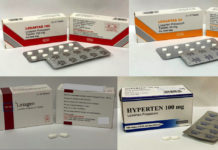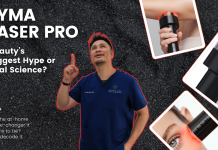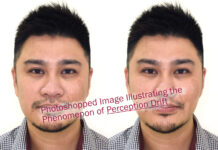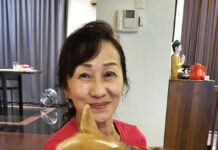In January 2024, my dog and best friend, Momo died. He lost his battle with hemangiosarcoma, a deadly cancer. On the same day, I contracted Covid-19 for the third time.
When Covid-19 Lingers : More Than Just a Cold
The symptoms of the recent Covid-19 infection were not severe – sore throat, mild aches, runny nose, and were gone before I knew it. Naturally, I did not think much of it – it felt, as many will describe, just like a regular cold. For the same reasons, I also did not think much about how tired I had been on a day-to-day basis since January. With the grief of losing my dog, my busy work schedule, conferences, and the Society of Aesthetic Medicine conference I was presiding over looming closer, it difficult to differentiate what was causing the fatigue.
The progression was insidious. At first I found it harder and harder to get through the day. And then, I could not even get out of bed easily. My joints were aching – every one of them. In the past, I could go one full day in clinic without a break, but soon I had to take a one, then a few, then several in between patients. Soon, I could not lift my arms anymore, making holding any laser difficult. Even performing a simple laser procedure was painful. At the same time, I experienced periods of mental fogginess – a loss of words for example, or an inability to so simple arithmetic.
But pain aside, the worst part of the it all was how it affected me mentally.

Biological mechanisms underpinning the development of long COVID,
iScience,Volume 26, Issue 6, 2023, 106935, ISSN 2589-0042,
Post Covid Mood Changes
There was a strong sense of helplessness because I am used to functioning at high-speed, and it was difficult for me to accept that I couldn’t even get through the day without painkillers. For my staff who are so used to packing appointments for me, they too cannot understand why I was slower and slower, and still continued to fill my day despite reminding them not to.
There was often a backlog of patients in clinic. Some patients (pardon the pun) became impatient, sending my staff into panic and urging me to continue working when I simply could not. The feeling of despair grew, when I could not cope with work, in a vicious cycle that left my mental health spiralling downhill very quickly.
Turning the Tide : Understanding the Fatigue
My staff only understood something was wrong when they found me in pain, often teary, and unable to go on.
Gradually, my friends started to expressed concern about how quiet and unresponsive I have become. It was only then that I began to carefully think about what was happening to me. When you are constantly in distress and just trying to survive the day, it is not easy to take a step back to gain insight about what’s wrong.
The symptoms I am experiencing were very close to fibromyalgia – extreme fatigue, mood changes, pain. However coupled with the relation with Covid-19 in January, it all came together that I could be suffering from long Covid.

Sarzi-Puttini, P., Giorgi, V., Marotto, D. et al. Fibromyalgia: an update on clinical characteristics, aetiopathogenesis and treatment. Nat Rev Rheumatol 16, 645–660 (2020).
Long Covid and Fibromyalgia: Understanding Symptoms and Treatment
Long Covid is used to describe a medical condition where people experience persistent symptoms after an acute Covid -19 infection. The symptoms can be vague and widespread, such as:
- Respiratory – cough, breathlessness
- General – fatigue, inability to focus mentally
- Mental Health Issues – stress, depression
- Pain – muscle aches, joint pains
Long Covid often manifests about 3 months after the acute infection and persists for 2 months or more. It affects 10-20% of people who catch Covid-19. Treatment is largely supportive – rest, reducing workload and stress, and medications to target specific symptoms, e.g. painkillers for muscle pain. In severe cases, rehabilitation and physiotherapy may be required
The symptoms for Long Covid, such as fatigue, pains, mood changes, and cognitive impairment, are very similar to other conditions – fibromyalgia (more pain dominant), and chronic fatigue syndrome (more fatigue dominant). Interestingly, fibromyalgia and chronic fatigue syndrome can also be triggered by a viral, bacterial or parasitic infection, and experts are starting to think that there is a connection between the 2 conditions.
The cause for both conditions are unknown, but there is most likely an auto-immune component to it. The immune system is triggered by the infection to either attack our own tissues, or errantly release immune mediators such as prostaglandins and cytokines which cause excessive inflammation in multiple organ systems – hence the pain and fatigue. For this reason, similar symptoms are also experienced by some autoimmune-disease sufferers.
The problem is – the symptoms are so vague and non-specific that both doctors and patients alike often miss them, or brush them aside – sometimes labelling patients as being “mental” and just imagining the problem.
ONDAMED: Pulsed Electromagnetic Field Therapy as Alternative Therapy
For awhile now, I have been using the Ondamed – a treatment utilising electromagnetic waves, in my wellness centre. The treatment is not mainstream, belonging to the realm of energy healing.
Ondamed is a technology based on Pulsed Electro-Magnetic Fields (PEMF). Specifically, it uses ultra low power electromagnetic wavelegths, delivered deep into a targeted region of user’s body, to stimulate and induce the tissues to heal.
The treatment is centered around restoring balance to our bodies – a concept very much related to traditional medicine systems – such as Chinese, and Ayruvedic. I readily adopted the system also because it bore similarities with my religious practice – Tibetan Buddhism, where Rinpoches (high monks) use energy waves to heal through prayers, rituals and offerings.
The cells in our bodies have innate natural frequencies, and communicate with each other via electrical signals. Ondamed simply identifies which of these frequencies is out of sync, and uses the electromagnetic waves to tune them back to the natural frequency. The implications are far reaching – as we know in Chinese medicine concepts that many illnesses stem from the upset of the balance in our bodies. Most commonly, that imbalance results in fatigue, mood related changes.
While there are other gadgets (e.g. the magnetic necklaces my father used to wear) and machines which work similarly, Ondamed goes one step further. It allows the practitioner to diagnose and access the patient’s needs through feedback from the pulse of the patient – and select the most appropriate frequencies for the patient. It is the only device capable of “biofeedback”, so that we come up with a personalised therapeutic intervention for the patient.
With my blood tests turning out mostly normal, I knew that my body was out of balance, and chronic painkillers was not the answer. Ondamed was the next treatment option I considered for my chronic fatigue symptoms.

ONDAMED: Clearing The Fog, and Moving Forward
The Ondamed treatment involves diagnosing the problem, hooking myself up to the various applicators, then simply, sitting there, which is the most difficult part. Each treatment takes about an hour, and should be done at least twice a week. I underwent an intensive course of daily 1 hour treatments. The biggest and most obvious change after 2-3 sessions was an improvement in mood, and mental clarity. It was as if the fog had cleared from my brain, allowing me to make better decisions, and take concrete steps to improve my situation. I was much happier. This, with continued treatments, allowed the pain to become manageable. Instead of everyday being a bad day, there were good and bad days. I remembered the day, about 2 weeks after initiating treatment, when I could climb up the stairs again. It was very emotional.
4 months on, I am much better, with more good days than bad. On retrospect, what I experienced was a combination of factors: exhaustion from looming after my dying dog, the grief of losing Momo, and my good friend Wilson a week earlier, a punishing work schedule, multiple conferences, and Long Covid. It cumulated in the what was the worst burnout, and fatigue I experienced. I am extremely fortunate to be able to pull out of it relatively quickly.

Self Care, And Its Challenges
In a fast-paced society like Singapore, where there is rarely time to take a breather, we often neglect our health – both mentally and physically. Upon sharing my experience with my patients – many who are high achievers, I realised the problem is more common that we know. Many of us push our minds and bodies past the limit, not taking time to rest, recharge and recover when needed. As doctors, we too need to recognise that chronic fatigue is a very real problem, and not brush away our patients concerns.
While evidence-based medicine is the mainstay of treatment, there are instances when we can consider alternative medicine as adjunct treatments to complement primary therapy – such as diet, supplements, and in my case, energy medicine in the form of the Ondamed. In my experience, the Ondamed is a great option for conditions which affect the mood, and balance of the body – for example, fatigue, insomnia.., and of course, post-infectious brain fogginess and tiredness. It allows our bodies to heal faster, so that we can get back on our feet again.
If you are experiencing similar symptoms as I did, please reach out to your friends and family. It is ok to cry for help. Nothing is more important that our health, and if people who truly care about you, will understand that you need to take some time to rest and recover.
References:
- National Institutes of Health: Covid-19 Research – Long Covid
- What is Long COVID and how is it treated – National Centre for Infectious Diseases
- Ondamed Publications
- Rubeshan Perumal, Letitia Shunmugam, Kogieleum Naidoo, Dave Wilkins, Alfredo Garzino-Demo, Christian Brechot, Anders Vahlne, Janko Nikolich, Biological mechanisms underpinning the development of long COVID, iScience, Volume 26, Issue 6, 2023, 106935, ISSN 2589-0042
- Sarzi-Puttini, P., Giorgi, V., Marotto, D. et al. Fibromyalgia: an update on clinical characteristics, aetiopathogenesis and treatment. Nat Rev Rheumatol16, 645–660 (2020).
Footnote:
I would like to thank my staff and colleagues for making sure the clinic continued to run when I was unwell. I would like to express my sincerest gratitude to my patients, who, despite having to wait longer for their treatments, have been very understanding over the past few months.
Finally, I would like to thank Gladys, who not only introduced me to the Ondamed, but helped treat me with it, when my mood was at my lowest.
















